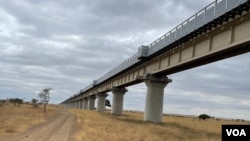Some 150 countries, many of them in Africa, have signed on to China’s 10-year-old Belt and Road Initiative, also known as the BRI. And while the multibillion-dollar project has helped bring roads, rails and infrastructure to many poor countries, it has also left some of those countries saddled with debt.
In Kenya, for example, the Standard Gauge Railway, or SGR, which debuted six years ago, was hailed by Kenyan officials as one of the biggest and most successful local infrastructure projects since the late 1800s.
Travel time from Mombasa to Nairobi used to be up to 10 hours. Now, it takes five to six.
"If you are a businessman, you are going for an interview, it saves you time," rider Denis Ombuna told VOA last week as he got off the train at the Syokimau Nairobi Terminus station.
Another rider, Dickson Okong’o, complained the seats are not comfortable in economy class but said the train is a safe mode of transport and the scenery is wonderful. “When I was coming today, I was able to see an antelope, an elephant, a zebra. … Sometimes I have to go to Nat Geo [TV] to watch them,” he said.
Kenya borrowed some $5 billion from China to build railway lines connecting the port city of Mombasa to Nairobi and Nairobi to Naivasha.
The lines are part of Chinese leader Xi Jinping’s signature foreign policy. The global infrastructure, trade and telecommunications project includes the goal of connecting Kenya to Uganda, Rwanda and South Sudan.
“The good side is it’s a framework for transportation: transportation of goods, transportation of cargo,” Kenyan economist Victor Kimosop told VOA.
But Kimosop said some elements of the project could have been done differently.
“I wish those responsible for SGR would’ve looked at the repayment,” he said. “It’s a massive investment project ... to have repayment being done in 20, 30 years. That was quite ambitious. … The other thing is also our model of development, on compensation. It makes development very expensive … and it also opens up room for corruption.”
During its construction, other critics of the project protested its potential impact on wildlife. A part of the railway cuts through the Nairobi National Park.
On Friday, Kenya Deputy President Rigathi Gachagua told a local radio program that when President William Ruto travels to China later this month, he will ask Beijing for an additional $1 billion loan to complete other stalled road construction projects. Ruto's plan will also include a request to lengthen the maturity periods of existing loans.
African nations were viewed as natural participants in BRI for a number of reasons, said David Sacks, fellow at the Council on Foreign Relations in New York.
“Africa’s population is growing significantly, and there’s a need on the continent for more infrastructure, and China has the experience and the expertise in its view to provide the roads, railways and ports that African countries are looking for,” he told VOA. “From the Chinese perspective, Africa is desirable because it wants to secure input for its manufacturing sector and, when it looks around the world, a lot of these copper, cobalt or other minerals are found in Africa.”
Countries such as Ethiopia and Zambia have also green-lighted massive Chinese-built infrastructure. But Zambia is struggling with the resulting debt burden. It was the first country to default on its debt during the pandemic.
Zambia President Hakainde Hichilema, who’s been looking to restructure the nation’s loan with China, recently visited his Chinese counterpart.
The West has been critical of China for lending to poor countries and says it must quickly provide relief to those that ended up with unsustainable and unpayable debts.
“Prompt action on debt is in China's interest,” Janet Yellen, the U.S. Treasury secretary, said earlier this year. “Delaying needed debt treatments raises the costs both for borrowers and creditors. It worsens [the] borrowers' economic fundamentals and increases the amount of debt relief they will eventually need.”
Sacks said the narrative that China actively goes around the world seeking to ensnare nations into debt traps is simplistic. He noted that many countries joined BRI when economic growth was quite robust and didn’t expect leaner times.
“The first shock was of course the COVID-19 pandemic, which really eviscerated global economic growth but also hit the developing world particularly hard,” he said. “The second one was the war in Ukraine. [For] Africa, major importers of food as well as oil, prices for those commodities have gone up tremendously.”
A recent Boston University study found that lending to Africa by China has dropped to the lowest level in two decades. Analysts say that while the BRI is here to stay, Beijing may be moving toward smaller investments.





![One rider on the train from Mombasa to Nairobi said he appreciated the view. "When I was coming today, I was able to see an antelope, an elephant, a zebra. … Sometimes I have to go to Nat Geo [TV] to watch them,” he said. (Mariama Diallo/VOA)](https://gdb.voanews.com/01000000-0aff-0242-810d-08dbca5eda61_cx0_cy11_cw100_w250_r0_s.png)





